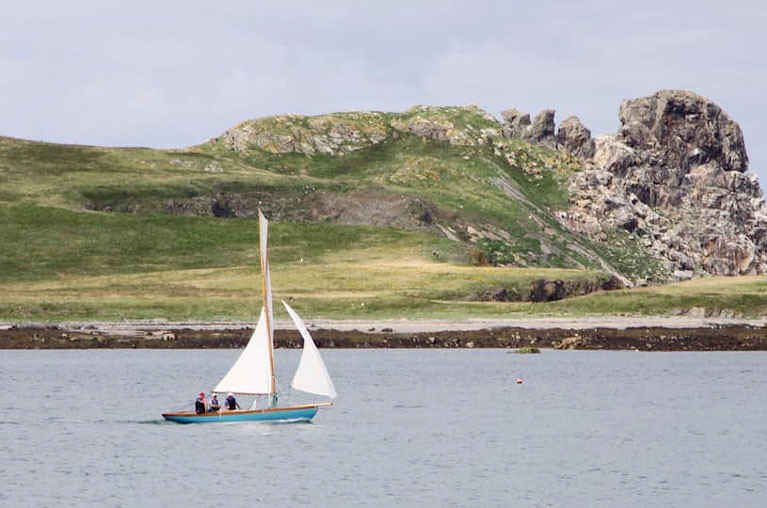The Howth 17s have been racing in their “little piece of Connemara that’s somehow in Leinster” for 122 years. And when some years ago they decided to make their annual championship into something special, they re-titled it the Howth 17 Worlds. But within the powers-that-be - where a certain lack of light-heartedness is the default mode - it was decreed that they mustn’t do that again. So the following year the Howth 17 Galactic Championship was staged….
Thus for some years now a sort of truce seems have existed over the class’s determination to call its annual major the National Championship, and 2020's comes up this weekend, with the 1907-built Deilginis (Massey, Toomey & Kenny partnership) defending the title.
 The defending champions. The syndicate on Deilginis ensure maximum speed through total concentration, and the use of liquid adjustable ballast when needed
The defending champions. The syndicate on Deilginis ensure maximum speed through total concentration, and the use of liquid adjustable ballast when needed
And for those who would claim to find some oddity in a one-harbour class having a Nationals, the Seventeen sailors will magisterially point out that not all the participating crews live in the village.
On the contrary, some of them reputedly come from the bandit country on the other side of the Hill of Howth at Sutton, while there are even a few from nearby Ireland in the trackless wilds to the west beyond the peninsula’s isthmus frontier. And unbelievably, the class’s racing is so good that it draws in one or two aliens from south of the Liffey.
With the word from the west in Connacht being something along the lines that all those who would normally go to Mallorca have descended on Roundstone, the shy creatures who sail Seventeens have put all thoughts of the crowded Atlantic seaboard out of their heads, and they’re focusing on racing in home waters which suddenly seem the most exotic in Ireland.
 It goes with the territory….while Howth YC Commodores are permitted to sail in other boat types, they’re expected to have more than a passing acquaintance with the soul of the club through the Howth 17s. Current Commodore Ian Byrne, though best-known as the owner of the Sunfast 32 Sunburn, solves the problem through part-ownership of the Seventeen footer Gladys, which he regularly races and is seen here shining with the Commodore at her launching
It goes with the territory….while Howth YC Commodores are permitted to sail in other boat types, they’re expected to have more than a passing acquaintance with the soul of the club through the Howth 17s. Current Commodore Ian Byrne, though best-known as the owner of the Sunfast 32 Sunburn, solves the problem through part-ownership of the Seventeen footer Gladys, which he regularly races and is seen here shining with the Commodore at her launching
Admittedly in current circumstances not all the boats have yet been put afloat, but they’ll muster a dozen or so for the big one, with a user-friendly programme of a first race in Friday night (August 7th), then it’s hard going on Saturday with four races scheduled, while Sunday morning is kept in reserve in case there’s any slippage. But the tradition is that it’s done and dusted by Saturday night, upon which everyone springs to the mainbrace, and great is the splicing thereof (within socially-distant compliance, of course).
 Orla was built in 2018 in France using a boatbuilding school scheme. Owned by Ian Malcolm, she is currently raced by Gerry Comerford as he works on completing his own new Howth 17 in his personal Men’s Shed beside his house.
Orla was built in 2018 in France using a boatbuilding school scheme. Owned by Ian Malcolm, she is currently raced by Gerry Comerford as he works on completing his own new Howth 17 in his personal Men’s Shed beside his house.
While Deilginis has been showing her traditional speed, Gerry Comerford in the Ian Malcolm-owned new boat Orla has had a much-celebrated win, while Ian Malcolm himself has found new speed in his 1898-built Aura.
The word is it’s all down to a change of topside colour. During what seemed like many decades (it was actually forty years), Ian perfected an attractive pale cream finish for his topsides, and black anti-fouling below. For those who asked, the answer was that this was the colour scheme of a pint of Guinness.
Yet everyone knows that the essence of Guinness is that it should be a slow procedure, and there were definitely times when Aura’s performance reflected this.
But last year, with things a bit hectic at launching time, Aura’s owner grabbed the nearest tin of topside enamel in his rather wonderful worshop/boatshed, and Aura emerged with topsides of a sort of orange colour, and it was immediately obvious she was faster.
 The secret ingredient. It’s reckoned Aura’s new speed in 2020 is due to a change of livery to this “go-fast blue” after forty years of “slow-is-best” Guinness colours.
The secret ingredient. It’s reckoned Aura’s new speed in 2020 is due to a change of livery to this “go-fast blue” after forty years of “slow-is-best” Guinness colours.
So this year she has a new colour yet again, a rather stylish shade which has already been dubbed “go fast blue” by the rest of the class, as Aura has been in the frame many times, quite often with the bullet, in this truncated season.
Whether go-fast-blue works in a National Championship remains to be seen. But when you’ve managed to transpose a real sense of Connemara to Howth for the hollyers - rather than drag yourself there through thickening crowds - then all things are possible.


























































